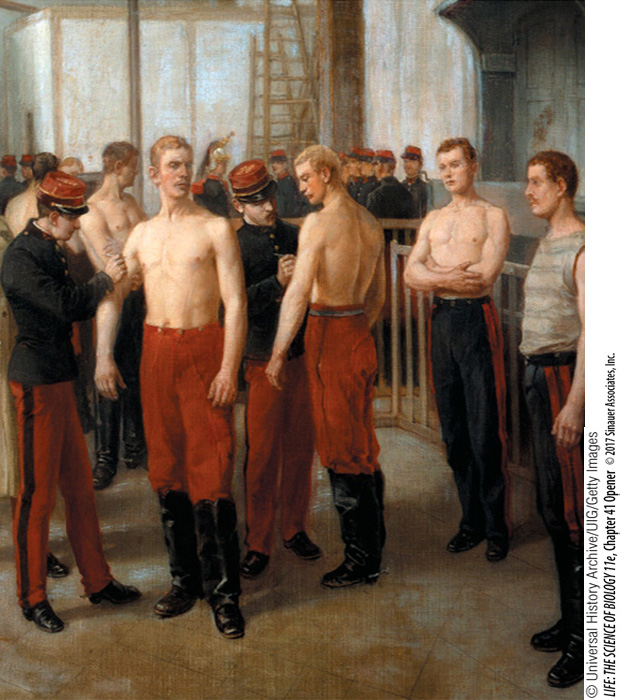Chapter Introduction
867
41
key concepts
41.1
Animals Use Innate and Adaptive Mechanisms for Defense
41.2
Innate Defenses Are Nonspecific
41.3
Adaptive Defenses Are Specific
41.4
The Humoral Adaptive Response Involves Antibodies
41.5
The Cellular Adaptive Response Involves T Cells and Receptors
41.6
Malfunctions in Immunity Can Be Harmful
Immunology:
Animal Defense
Systems

investigating life
Vaccines and Immunity
Five tiny vials in deep freezers, three in Bethesda, Maryland, one in Atlanta, Georgia, and one in Siberia, are all that is left of the smallpox virus. Smallpox killed more than 300 million people in the twentieth century, but the disease made its last appearance in 1978, thanks to vaccination. A vaccine is usually an inactive form of a pathogen or toxin that provokes the immune system to produce antibodies: specific proteins directed against the target. The immune system destroys whatever is bound to the antibodies.
The eradication of smallpox was a spectacular international accomplishment. So why hasn’t vaccination for other potentially lethal diseases such as the flu (influenza) been widely accepted by the public? More than one-
Unfortunately, those who refuse vaccination may harm people other than themselves. A vaccination program can control or eradicate a disease only if a high percentage (typically above 80 percent) of people are vaccinated, thus disrupting the chain of infection from person to person. A very high level of vaccination results in “herd immunity,” a state in which even those who cannot be vaccinated or who have weak immune systems are protected from infection. This protection is lost if the vaccination rate falls below the level needed for herd immunity. Those who are old or sick, and infants whose immune systems have not yet fully developed, are most at risk.
The best way to develop herd immunity in a population is compulsory vaccination. In many countries, vaccination is a prerequisite for school enrollment and military enlistment and is required during epidemics. For example, during the periodic smallpox epidemics during the twentieth century in the United States, doctors accompanied by police would go into neighborhoods where the disease raged, vaccinating all those who were uninfected and removing infected people to quarantine. You can imagine the reaction of parents whose children were taken away, often to die. Henning Jacobson was arrested when he refused vaccination during a smallpox epidemic. He took his case to the U.S. Supreme Court, which ruled in 1905 that while personal freedom is important, each state is entitled to protect its citizens. This provided a legal framework for compulsory vaccination that continues to this day. But opposition and court challenges continue.
What are the mechanisms and implications of long-